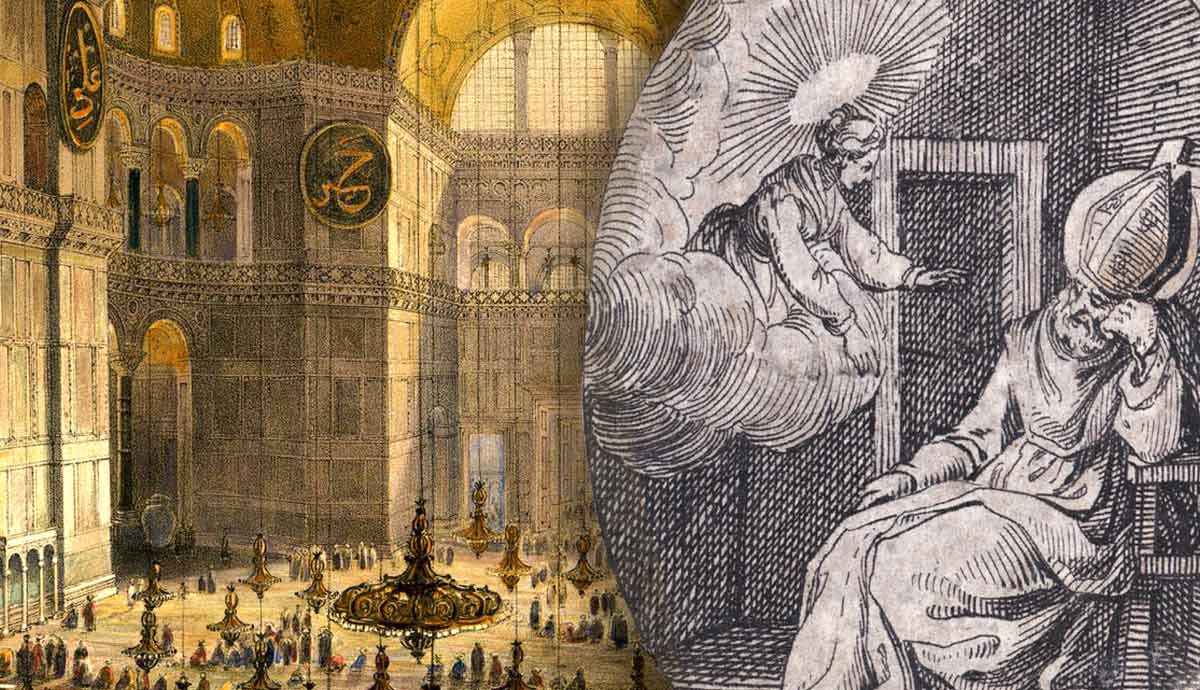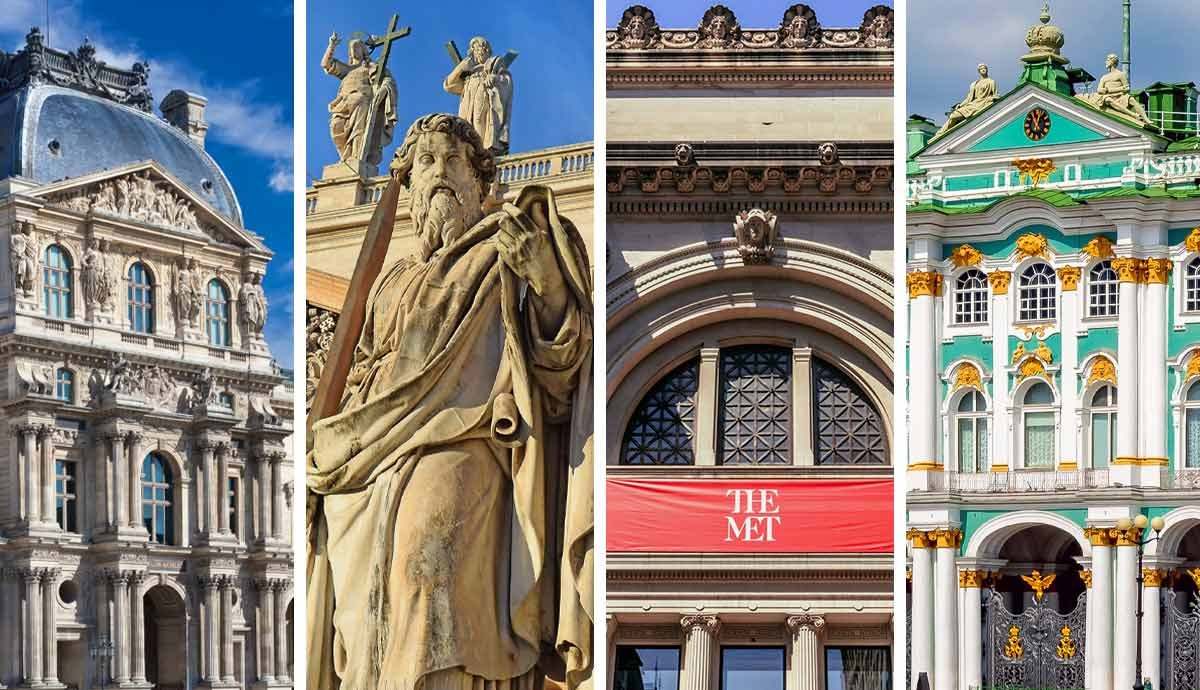
Iconoclasm is a period of Byzantine history usually chronologically placed between 730 and 843. During these 113 years, with a short intermission between 787 and 815, iconography, the more than 4 centuries-long artistic tradition of the Eastern Roman Empire suffered great losses. This meant that by imperial decree, the production of religious images was not only prohibited but the already existing artworks were actively destroyed. Taking root in the political and religious elites in Constantinople, this movement had a long-lasting effect on the medieval world. Often described as a “dark age” of Byzantine art, Iconoclasm left an undeniable mark not only on the future of the Byzantine Empire’s art but on medieval Europe in general.
Iconoclasm as an Imperial Movement

Between 726 and 727, an enormous volcanic eruption hit the islands of Thera and Therasia in the Aegean Sea. Byzantine Emperor Leo III interpreted this natural disaster as divine anger that could only be appeased by banning the worship of icons. Being born in Germanikeia, where the iconoclast tradition of monophysitism was widespread, Leo III had already shown intentions of pursuing this path.
Thus, with a series of edicts issued between 727 and 730, Leo III officially launched the period of Iconoclasm throughout his empire. The pro-iconography Patriarch Germanos completely rejected such transgression against the Church of Constantinople, so he was replaced by the iconoclast Anastasios.
Even though Leo III ignited the iconoclastic fervor, it peaked during the reign of his son Constantine V. Constantine took it upon himself to write 13 theological treatises on Iconoclasm. In the two remaining ones, he rejects the possibility of representing the divine nature of Christ. He summoned the iconoclastic Council in Hieria in 754 and officially proclaimed icons as idols, ordered their destruction, and cast an anathema on all iconodules (servants of images). Going further, Constantine V ordered prosecutions of his religious and political adversaries, which were mainly abbots and monks. Equally fanatic in their convictions as Constantine was in his, iconodules in Constantinople gathered around Stephen the Younger, who was killed by a mob in 765.
The Triumph of Orthodoxy

A short intermission ensued between 787 and 815, thanks to a series of Orthodox emperors who did not subscribe to the iconoclast movement, starting with Empress Irene. Irene summoned an iconophile council in Nicaea in 787, later proclaimed as the 7th Ecumenical Council, negating the Council of Hieria. The ideas of the council were mainly drawn from the writings of John of Damascus, an earlier opponent of Iconoclasm.
Although Leo V returned the Church politics to Iconoclasm in 815, the movement didn’t have the same power and significance it had in the 8th century. The same year, Leo V summoned the second Council of Iconoclasts, overturning the decisions of the 7th Ecumenical Council, casting an anathema on its participants, and proclaiming the Council of Hieria as legitimate.
Thus, the second wave of Iconoclasm was marked by the reigns of Leo V, Michael II, and Theophilos. Michael’s contribution to the iconoclast movement was banning the discussion of icons, and Theophilos renewed the persecutions of those who worshiped them. After Emperor Teophilos died in 842, his wife Theodora and the new patriarch Methodius summoned a new council in Constantinople, thus reaffirming the decisions of the pro-iconography 7th Ecumenical Council. At the end of the council, a great procession was carried out throughout the city, celebrating the victory over the iconoclast heresy.
The Basis of Iconoclasm

Besides Leo III’s interpretations of natural disasters as the signs of God’s anger, there were several theological and philosophical arguments for the destruction of icons. Indeed, the most important one came from the Old Testament and one of God’s 10 Commandments:
“You shall have no other gods before me. You shall not make for yourself an image in the form of anything in heaven above or on the earth beneath or in the waters below. You shall not adore them, nor serve them.”
(Exodus 20:3-5)
The other arguments came in the form of the Neoplatonist teachings of 3rd-century philosopher Plotinus. To Neoplatonists, the material world was not necessarily evil but was only an “image” or a reflection of a higher world. To them, humans should strive toward the archetype of these images. In that sense, the only thing that should be worshiped is that archetype itself, not its copy. Another source could have stemmed from the writings of Eusebius of Caesarea, a 4th-century historian and theologian who considered that the divine nature of Christ is incomprehensible.
Though reasons for Leo III’s Iconoclasm seem primarily religious, historians have argued that the emperor wanted to restrain the growing political power and wealth of monasteries by prohibiting icons. Another hypothesis, though less likely, argues that the emperor sought to integrate Muslim and Jewish populations, who viewed Christian images as idols.
The Art of Iconoclasm

The creation of images integral to Byzantine art stagnated during the Iconoclasm period. So what kind of art did the “destroyers of icons” make?
Since Iconoclasm was a movement bound to the politics of the capital and mostly rejected in the other parts of the Empire, a few examples still survive.
A key example of art during Byzantine Iconoclasm was the cross in the apse of Hagia Eirene, one of the most important churches of Constantinople. The church was severely damaged by the earthquake of 740 and probably reconstructed by the Iconoclastic Emperor Constantine V, during which time the cross was added; the motif of a cross was one of the rare symbols allowed by the State during this period.
Mosaics of plain crosses can also be found in other churches in Constantinople, including the Hagia Sophia. Next to the lunette above the imperial door in Hagia Sophia are two other lunettes with crosses. Unusually, these crosses were not replaced by other mosaics nor destroyed in the ensuing centuries.
In Defense of Icons

Though not alone, John of Damascus was one of the most productive and efficient defenders of the veneration of icons. Not only did John oppose Iconoclasm but the Islamic prohibition of images as well. His most significant work is Three Treatises on the Divine Images. In these treatises, after drawing the line between correct and incorrect worship, John attempts to define the nature of images. For John, the validity of images is based on the belief that Christ and humankind itself are images of God, material manifestations of a spiritual ideal.
For his defense of the use of images, John of Damascus was canonized by the Patriarchate of Constantinople. John built up a whole theology of icons, seeing them as a symbol in the Neoplatonist sense and connecting the image of Christ with his incarnation.
Another zealous champion of icons was Theodore the Studite, the abbot of the Stoudios monastery in Constantinople. Between 787 and 815, his epigrams celebrating icons were placed at the Chalke Gate of the Imperial Palace. Theodore took the leading role in the iconodule opposition during the Second Iconoclasm. Even though he changed his standing on icons in a few instances, Theodore composed a polemic discourse, the Refutatio, refuting the arguments of the new Iconoclasts.
Art After Iconoclasm

The importance of the iconoclastic controversy and its immediate influence on art can be seen in one of the remaining 9th-century manuscripts: the Chludov Psalter, made around the middle of the 9th century, just as Orthodoxy triumphed over Iconoclasm. Part of the Psalter discusses the controversy using illustrations. One of the pages represents the Crucifixion when Roman soldiers offer vinegar on a sponge to Christ. It illustrates Psalm 69: “They also gave me gall for my food, and for my thirst they gave me vinegar to drink.”
In the foreground is the portrait of the last iconoclast patriarch of Constantinople, John Grammatikos, standing before the icon of Christ. Purposely caricatured with hair sticking out on all sides, Patriarch John attempts to erase the image of Christ with the same pole and sponge the Roman soldier uses in the scene of Crucifixion.
The reestablishment of the veneration of icons gave an opportunity for a new decoration program of churches based on a new theology of images. The first image introduced to the Hagia Sophia was the Virgin and Child in the apse around 867. The image was accompanied by an inscription, now partially destroyed: “The images which the impostors had cast down here pious emperors have again set up.”
The Long-Lasting Consequences of Iconoclasm

Iconoclasm didn’t only leave a dent in the history of Byzantine art. The wider political consequences were seen by the estrangement of the Roman Catholic Church, which rejected the teachings of Iconoclasm. This started a conflict between the Papacy and the Byzantine emperor and the iconoclast patriarchs of Constantinople. Constantine V took the Roman ecclesiastical jurisdiction over the Balkans and gave it to the Patriarchate of Constantinople. As a consequence, Rome lost religious control over the Balkans, except on its west coast.
Another equally important consequence was the Pope’s willingness to seek political alliance and protection from the Frankish lords in the West. Constantinople lost the possibility to influence the politics of the Roman Church, which was now in the hands of the Franks. Charlemagne finally defeated the Longboards, something the Byzantines failed to do, and secured the Pope’s good favor.
Even though the Byzantines shortly returned to the veneration of icons, Rome’s newfound relationship with the Franks could not be broken. Thus, in 800, Charlemagne was crowned the Emperor of Rome in Saint Peter’s Basilica. By damaging the relationship between Rome and Constantinople, Iconoclasm helped usher in a new age of Western Europe under the rule of the Carolingian Empire.









